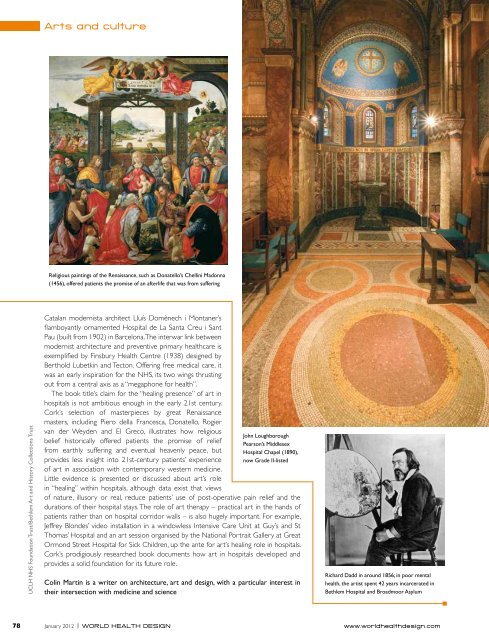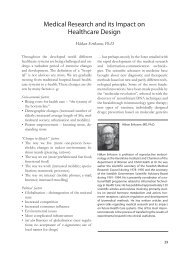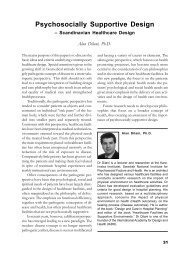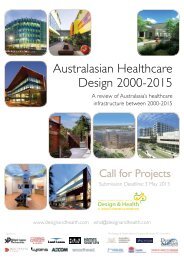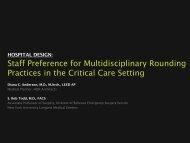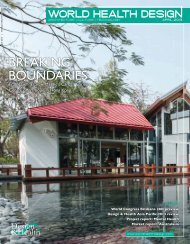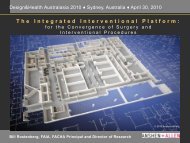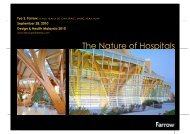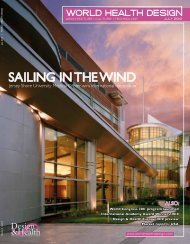RESTORATIVE SpAcE - the International Academy of Design and ...
RESTORATIVE SpAcE - the International Academy of Design and ...
RESTORATIVE SpAcE - the International Academy of Design and ...
Create successful ePaper yourself
Turn your PDF publications into a flip-book with our unique Google optimized e-Paper software.
Arts <strong>and</strong> culture<br />
Religious paintings <strong>of</strong> <strong>the</strong> Renaissance, such as Donatello’s Chellini Madonna<br />
(1456), <strong>of</strong>fered patients <strong>the</strong> promise <strong>of</strong> an afterlife that was from suffering<br />
UCLH NHS Foundation Trust/Bethlem Art <strong>and</strong> History Collections Trust<br />
Catalan modernista architect Lluís Domènech i Montaner’s<br />
flamboyantly ornamented Hospital de La Santa Creu i Sant<br />
Pau (built from 1902) in Barcelona. The interwar link between<br />
modernist architecture <strong>and</strong> preventive primary healthcare is<br />
exemplified by Finsbury Health Centre (1938) designed by<br />
Berthold Lubetkin <strong>and</strong> Tecton. Offering free medical care, it<br />
was an early inspiration for <strong>the</strong> NHS, its two wings thrusting<br />
out from a central axis as a “megaphone for health”.<br />
The book title’s claim for <strong>the</strong> “healing presence” <strong>of</strong> art in<br />
hospitals is not ambitious enough in <strong>the</strong> early 21st century.<br />
Cork’s selection <strong>of</strong> masterpieces by great Renaissance<br />
masters, including Piero della Francesca, Donatello, Rogier<br />
van der Weyden <strong>and</strong> El Greco, illustrates how religious<br />
belief historically <strong>of</strong>fered patients <strong>the</strong> promise <strong>of</strong> relief<br />
from earthly suffering <strong>and</strong> eventual heavenly peace, but<br />
provides less insight into 21st-century patients’ experience<br />
<strong>of</strong> art in association with contemporary western medicine.<br />
Little evidence is presented or discussed about art’s role<br />
in “healing” within hospitals, although data exist that views<br />
John Loughborough<br />
Pearson’s Middlesex<br />
Hospital Chapel (1890),<br />
now Grade II-listed<br />
<strong>of</strong> nature, illusory or real, reduce patients’ use <strong>of</strong> post-operative pain relief <strong>and</strong> <strong>the</strong><br />
durations <strong>of</strong> <strong>the</strong>ir hospital stays. The role <strong>of</strong> art <strong>the</strong>rapy – practical art in <strong>the</strong> h<strong>and</strong>s <strong>of</strong><br />
patients ra<strong>the</strong>r than on hospital corridor walls – is also hugely important. For example,<br />
Jeffrey Blondes’ video installation in a windowless Intensive Care Unit at Guy’s <strong>and</strong> St<br />
Thomas’ Hospital <strong>and</strong> an art session organised by <strong>the</strong> National Portrait Gallery at Great<br />
Ormond Street Hospital for Sick Children, up <strong>the</strong> ante for art’s healing role in hospitals.<br />
Cork’s prodigiously researched book documents how art in hospitals developed <strong>and</strong><br />
provides a solid foundation for its future role.<br />
Colin Martin is a writer on architecture, art <strong>and</strong> design, with a particular interest in<br />
<strong>the</strong>ir intersection with medicine <strong>and</strong> science<br />
Richard Dadd in around 1856; in poor mental<br />
health, <strong>the</strong> artist spent 42 years incarcerated in<br />
Bethlem Hospital <strong>and</strong> Broadmoor Asylum<br />
78 January 2012 | WORLD HEALTH DESIGN www.worldhealthdesign.com


